

#95 • September 2022 Community News Liver Self-Repair Plus World Hepatitis Day 2022 and more FREE! Please take one
Address
Country
Box 782
Town 5071
8362 8443
437
Adapted image by eranicle/istock

Please send all correspondence to
PO Box 782, Kent Town, SA 5071,
: James Morrison
photos in this publication
have been altered to disguise
details of members of the public.
resource was prepared and printed on Kaurna Country
HEPATITIS
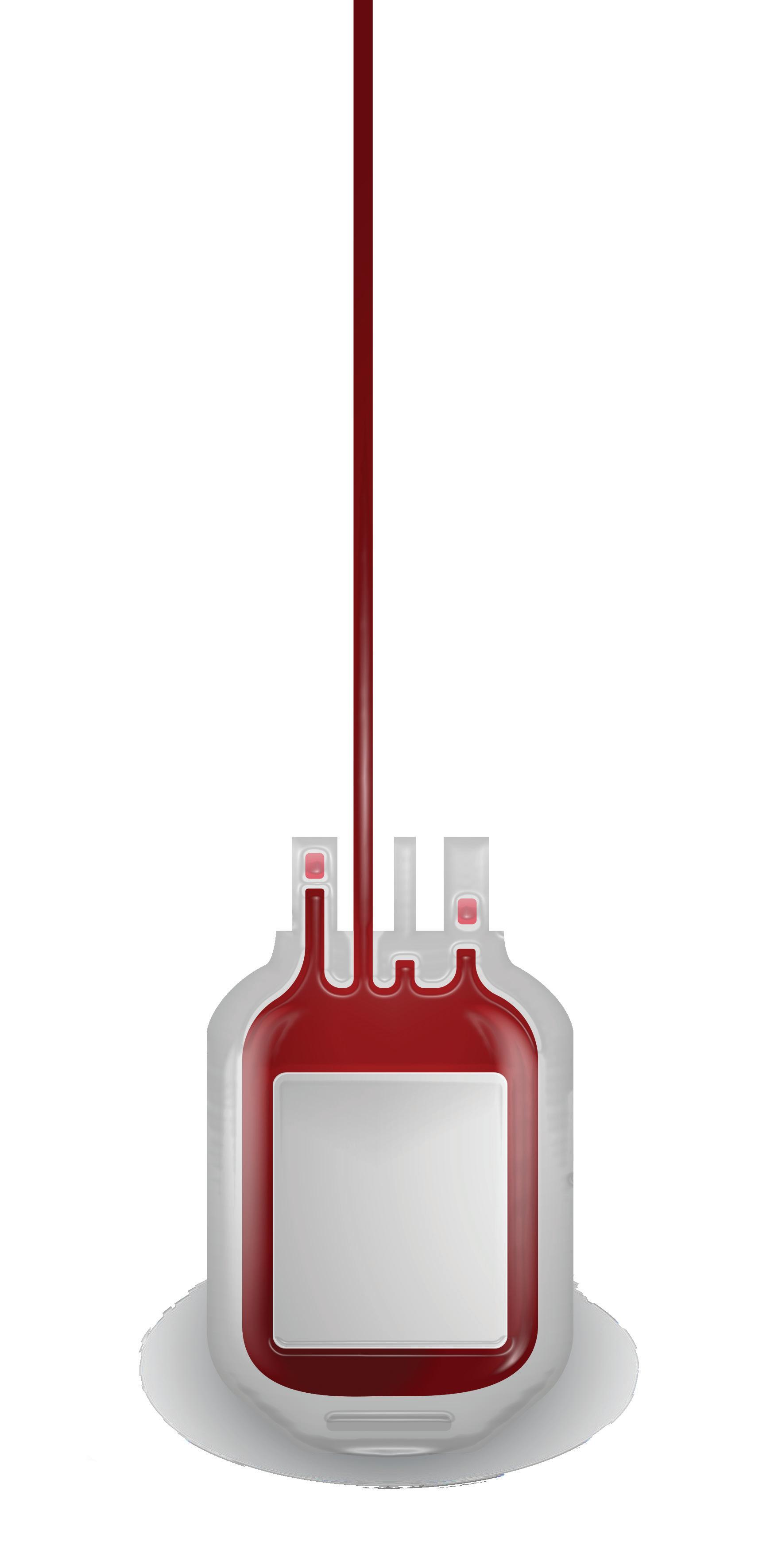
BOARD
Larkin
Alejo
Kelly
Ferguson
McGinnes
Raven
Paterson (CEO)
in this

given by your doctor or specialist.
welcome
Health has
not necessarily those of Hepatitis SA.
is not intended to take the place of medical
from Hepatitis SA members and the general public.
this
Postal
: Kaurna
PO
Kent
Phone: (08)
1800
222 Fax: (08) 8362 8559 Disclaimer: Views expressed in this newsletter are
Information contained
newsletter
advice
We
contributions
SA
contributed funds towards
program. Cover:
Correspondence:
The Editor at
or email editor@hepatitissa.asn.au. Editor
Some
may
identifying
This
Contents 1 It’s Your Right 2 Liver Self-Repair 4 New Hepatitis Update 6 Hepatitis A 7 Australia’s Biggest Quiz 8 World Hepatitis Day 10 John’s Story 12 Overdose Awareness Day 13 What’s On? / CNP Info 14 In Our Library Hepatitis SA provides free information and education on viral hepatitis, and support to people living with viral hepatitis.
SA
Chair Arieta Papadelos Vice Chair Bill Gaston Secretary Sharon Eves Treasurer Michael
Ordinary Members Julio
Catherine
Kate
Bernie
Sam
Kerry
Online: www.hepsa.asn.au HepSAY Blog: hepsa.asn.au/blog Library: hepsa.asn.au/library @HepatitisSA @hep_sa Resources: issuu.com/hepccsa Email: admin@hepatitissa.asn.au ISSN 2651-9011 (Online)
It’s Your Right New hep C testing/treatment campaign’s successes

The Eliminate Hepatitis C Australia Partnership (EC Australia) was created in 2018 to bring together researchers, scientists, government, health services and community organisations to work toward eliminating hepatitis C as a public health threat in Australia by 2030 (see last issue for more).
The EC Australia “It’s Your
The SA component of the IYR campaign was delivered between April and July in key metropolitan areas. Peer outreach focused on four areas: Adelaide and the inner suburbs, the northern suburbs, the southern suburbs and the western suburbs (including Port Adelaide). In each area trained IYR peers worked in pairs to talk to people who
each of the four areas during the time that the IYR peers were undertaking outreach. Incentives were provided to people who inject drugs if they undertook testing after being referred by the IYR peers. Additional ‘bring a friend’ incentives were aimed at increasing the number of conversations about hepatitis C and the number of people accessing hep C testing or
inject drugs by using peer engagement to increase access to hepatitis C testing and treatment. The campaign aims to shift perceptions about treatment and support people to prioritise treatment for hepatitis C.
bags, tourniquets) was used as an outreach engagement tool and given to people who inject drugs who engaged in HCV conversations with the IYR peers.
Hepatitis SA hep C peers conducted point-of-care testing for HCV at services in
The It’s Your Right campaign provided many opportunities for the CNP Peer Projects. The street/community-based outreach was a new way
September 2022 • HEPATITIS SA COMMUNITY NEWS 95 1
»(continued on p16)
Of all the body’s organs, the liver has the greatest power to regenerate itself.
Liver cell replacement and regeneration are vital functions that keep us feeling well and also maintain healthy metabolic activity. Some have suggested this is even the origin of the myth of Prometheus, whose liver was pecked out by an eagle each day, only to regrow each night.
It is only in cases of extreme damage that this ability fails, and a liver transplant becomes necessary. The liver’s self-repair is so effective that, when transplanting a liver from a larger to a smaller person (or from an adult to a child), a large amount of the organ can even be cut off before the transplant with the knowledge that the organ will repair itself in its new ‘home’. What has not been known is whether this ability to self-repair deteriorates with age. One study in rodents estimated the age of all the animals’ liver cells to be between 200 and 400 days, no matter the age of the animal itself. However, as ever, this sort of study is not a very good guide to how the bodies of humans work.
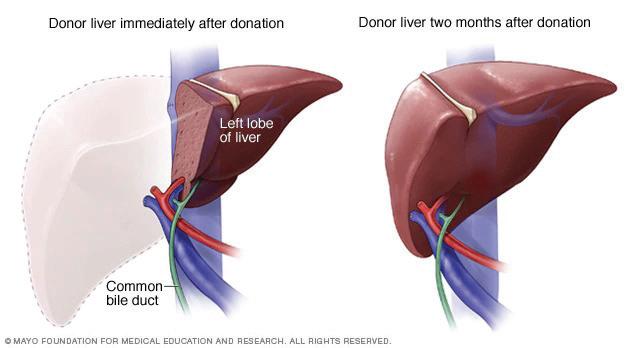
But now a new study published in the journal Cell
Systems, in May this year * , has shown that age does not slow down the liver’s regeneration. Instead, the self-repairing abilities stay consistent throughout a person’s lifetime. This means that, whether you’re 15 or 90 years old, your liver is usually around three years old, having completely recreated itself a number of times.
Lead researcher, Dr Olaf Bergman, of the Center for Regenerative Therapies in Dresden, explained that “while some studies pointed to the possibility that liver cells are long-lived, […] others showed a constant turnover. It was clear to us that if we want to know what happens in humans, we need to find a way to directly assess the age of human liver cells.”
During the study, Bergmann and his team of researchers used a technique called retrospective radiocarbon birth dating to determine the
age of livers in a number of people who had died between the ages of 20 and 84. In each of them, liver cells were consistently aged around the 3-year mark, no matter the age of the person.
The study did find that a small percentage of cells can live up to 10 years before renewing themselves. Dr Bergman suggested that this could potentially be a protective feature. When cells replicate rapidly–as they do in a fast-spreading bacterium or virus, for example–there is a significantly increased risk of mutation due to “spelling errors” possibly being introduced in the cell’s genetic code each time it is copied and reproduced. The long-lived liver cells seem to be those which carry more DNA information, and so this slower rate of change could prevent harmful mutations leading to problems like cancer. v
* Paula Heinke et al. (2022). Diploid hepatocytes drive physiological liver renewal in adult humans. Cell Systems, May 31, 2022. (www.cell.com/cell-systems/fulltext/S2405-4712(22)00171-5)
2 HEPATITIS SA COMMUNITY NEWS 95 • September 2022
Are Livers Forever Young? Prometheus and the eagle, depicted in a sculpture by Nicolas-Sébastien Adam, 1762 [background sky by Aukideezy/Vecteezy]
Liver regrowth diagram courtesy of the Mayo Clinic


New Hepatitis in Children





















































Possible cause for outbreak discovered

Between April and July of this year, 1,010 cases of severe hepatitis without any explainable cause were reported in children in more than 35 countries. Nearly half of these cases were in Europe, including over a quarter in the UK (see last issue for more information).





Usually, childhood hepatitis is caused by an infection from one of the hepatitis viruses (such as hepatitis A or hepatitis C). But although children were presenting with elevated levels of hepatitis markers in their blood, no traces of hepatitis viruses were detected in these children, nor in any of the related cases since.
Initial investigations found a potential link between











adenovirus infection and these cases of hepatitis. Adenoviruses are very common viral infections, especially in children. They typically cause infections such as mild colds, pink eye (conjunctivitis) or stomach problems. However, if they get to the liver they can on rare occasion cause hepatitis. However, given how common adenoviruses are in children –and because they rarely cause hepatitis in healthy people –it was difficult to say this was the probable cause.
A new study suggests that the spate of severe hepatitis cases seen in children may be the result of three factors working together: adenovirus, adenoassociated virus 2 (AAV2)










































and an underlying genetic predisposition to the disease.






A potential cause emerges

























In a pre-print study (which means it has not yet been reviewed by other scientists), a team of researchers looked at nine of the original hepatitis cases in April and conducted a large range of tests, seeking to find new or previously undetected viruses or genetic factors that may have caused hepatitis in the children.
The team found that all nine children had been infected with adeno-associated virus
2. They then compared their findings with 13 healthy children and 12 children
4 HEPATITIS SA COMMUNITY NEWS 95 • September 2022
Image by upklyak on Freepik
who’d had adenovirus infections but no hepatitis. Adeno-associated virus 2 was not detected in any of these children. This was a strong indicator that AAV2 was a cause of these mystery hepatitis cases.
Adeno-associated virus 2 belongs to a group of viruses called Dependoparvovirus which infects both humans and some primates. But what’s particularly interesting about AAV2 is that in order to infect the host, it requires another virus to also be infecting the host at the same time. It uses this helper virus in order to replicate inside human cells. The most common helper viruses of AAV2 are adenovirus and herpesvirus.
The researchers found that six out of the nine patients they looked at had an adenovirus, while three had signs of a herpes virus. This makes it’s likely these hepatitis infections were caused by a combination of AAV2 and one of these helper viruses.
Immune systems and infections
But both AAV2 and infections such as adenovirus and herpes virus are quite common in children, and most children infected with
these don’t go on to develop hepatitis. This means there must be an additional factor at play here, perhaps even at the genetic level.
The team of researchers then analysed the children’s genomes to look for specific immune system markers, called human leucocyte antigens. Immune system cells use human leucocyte antigens to detect other viruses and pathogens, and engulf them.
This then sends a signal to other immune cells which come along and destroy the pathogen. There are many different types of human leucocyte antigens, and which type a person has can determine which infections they may then be more susceptible to.
The researchers found that eight out of the nine children had a higher genetic prevalence of a certain type of human leucocyte antigen, which may have increased their likelihood of getting hepatitis symptoms from these viral infections. This type is also more common in people of European descent, which may further explain why these hepatitis cases were mainly seen in Europe.
Although it appears from this study that a combination of factors may explain the
sudden, severe hepatitis cases spotted in children, the study itself was small and only conducted on participants in Scotland. A much larger, peer-reviewed study will need to be done in order to fully figure out the exact link and how best to protect children going forward. Another factor that might have played into this were COVID-19 restrictions, which meant many children weren’t being exposed to these viruses and developing immunity at the ages they normally would have. This meant that when restrictions were lifted, children were exposed to these viruses all at once, which would overwhelm their immune system which is not prepared to deal with it.
However, research will need to be done in order to investigate whether or not this really played a role in the severe hepatitis cases. But if it is shown to be a cause, then it’s likely we will see fewer and fewer cases of hepatitis in children as the months pass since the last lockdown. v
Conor Meehan Senior Lecturer in Microbiology, Nottingham Trent University
This article is republished from The Conversation under a Creative Commons license. Read the original article at bit.ly/3AqM9Kd .
September 2022 • HEPATITIS SA COMMUNITY NEWS 95 5
Hepatitis A
Will understanding its replication lead to a cure?
Understanding how a virus replicates inside the body is crucial for working out how it spreads, and how to stop it. A research team at the University of North Carolina School of Medicine has been looking at this process for the hepatitis A virus (HAV).
Hepatitis A is a short-term liver disease caused by the hepatitis A virus. An infection does not cause chronic liver disease, but the symptoms can be debilitating. It is rarely fatal, but can sometimes lead to fulminant hepatitis (acute liver failure), which can lead to death. It is contracted through the faecal-oral route, ie usually by consuming food or water that has been contaminated with infected sewage. Though there is a vaccine for hepatitis A, there is no current treatment for it if a person becomes infected. By focusing on the replication cycle of the hepatitis A virus–how the individual viruses invade human body cells and hijack their machinery to create more of themselves–the UNC team, led by Dr Stanley Lemon, discovered that replication requires specific interactions
between a human protein (known as ZCCHC14) and a group of little-understood enzymes called the TENT4 poly(A) polymerases. The research also found that a particular medication known as oral compound RG7834, which is known to inhibit the hepatitis B virus, stopped hepatitis A replication at a key stage, making it impossible for the virus to infect liver cells. These findings, published in the Proceedings of the National Academy of Sciences*, are the first to demonstrate an effective drug treatment against hepatitis A . Dr Lemon, who in the 1970s and 80s was part of the research team that developed the first vaccine made of inactive hepatitis A to be administered to humans, said that the amount of research on HAV had dramatically decreased after the vaccine became widely available in the mid-1990s. Cases of HAV plummeted in the 2000s as vaccination rates skyrocketed, especially in countries like Australia with strong public health systems. Researchers turned their attention to hepatitis B and C viruses, both of which are
very different from HAV and cause chronic disease. “It’s like comparing apples to turnips,” Lemon said. “The only similarity is that they all cause inflammation of the liver.” HAV is not even part of the same virus family as hepatitis B and C viruses. But hepatitis A outbreaks have been on the rise since 2016, despite the effectiveness of the HAV vaccine. For example, in the US there have been 44,000 cases, 27,000 hospitalisations and over 420 deaths in the last five years.
In 2013, Lemon and his colleagues made several discoveries about the way that the hepatitis A virus changes dramatically inside the human liver. The virus hijacks bits of cell membrane as it leaves liver cells, cloaking itself from antibodies that would have otherwise quarantined the virus before it spread widely through the blood stream. That work led into the new research.
In normal human biology, TENT4 is involved in modifying the body’s RNA during the usual process of cell growth. In someone
al. (2022). The ZCCHC14/TENT4 complex is required for hepatitis A virus RNA synthesis. Proceedings of the National Academy of Sciences (PNAS), May 13, 2022. (www.pnas.org/doi/full/10.1073/pnas.2204511119
6 HEPATITIS SA COMMUNITY NEWS 95 • September 2022
* You Li et
)
infected with hepatitis A, the virus basically hijacks the TENT4 enzyme to build more of itself instead. This means that stopping the virus from accessing TENT4 could stop the virus from replicating and spreading.

Lemon’s lab then tested whether the compound RG7834 could work to block this process, since it has already been shown to block hepatitis B from replicating in a similar way, and indeed were able to show that it does.
However, this is not the final hurdle to be cleared. Though the amounts of RG7834 used in the study were shown to be safe, it is not known if it is non-toxic enough to be used for the longer timeframes required for treatment in the general public.
“This compound is a long way from human use,” Lemon said, “But it points the path to an effective way to treat a disease for which we have no treatment at all. The treatment for hepatitis A would be short-term, and, more importantly, our group and others are working on compounds that would hit the same target without toxic effects.” v

OnWednesday, 26 October 2022, as part of the Australian government’s commitment to find 50,000 people living with hepatitis C by the end of 2022, Hepatitis Australia will be hosting ‘Australia’s Biggest Quiz’.
The quiz is a community event intended to raise awareness of hepatitis C and its cure. There will be 16 quiz location across Australia, and people can also participate online. Hepatitis Australia aims to break a world record and make it into the Guinness World Record books by having more than 2,328 people participating in the quiz.
For South Australia, the live event will be held at a location in Salisbury. Hepatitis SA is promoting the event, and attending to assist with on-the-ground activities. See below for the details.
If you would like to put a team together, you can register free through the Australia’s Biggest Quiz website (australiasbiggestquiz.org). There will be lots of prizes up for grabs on the night—and don’t worry, the questions will not all be about hepatitis C! We hope to see you there. v

Wednesday, 26 October 2022 6:30–8:30pm Eureka Tavern: 10 Park Tce, Salisbury
Riverland Testing Campaign
Riverland Testing Campaign
In collaboration with the South Australian Viral Hepatitis Nurses and AbbVie, Hepatitis SA marked World Hepatitis Day in the Riverland with a series of education sessions and hepatitis C testing clinics. On 28 July, an education session was held for local GPs, nurses and pharmacists.
In collaboration with the South Australian Viral Hepatitis Nurses and AbbVie, Hepatitis SA marked World Hepatitis Day in the Riverland with a series of education sessions and hepatitis C testing clinics. On 28 July, an education session was held for local GPs, nurses and pharmacists.
Following the education sessions, four testing clinics were held in Barmera, Loxton, B erri and Renmark.
Following the education sessions, four testing clinics were held in Barmera, Loxton, Berri and Renmark.
92% of participants said they learnt a lot about hepatitis B and hepatitis C. All participants said the session improved their understanding of hepatitis C Point of Care Testing (PoCT), and that signi�cantly increased their likelihood of referring patients to the free hepatitis C testing clinics in the Riverland.
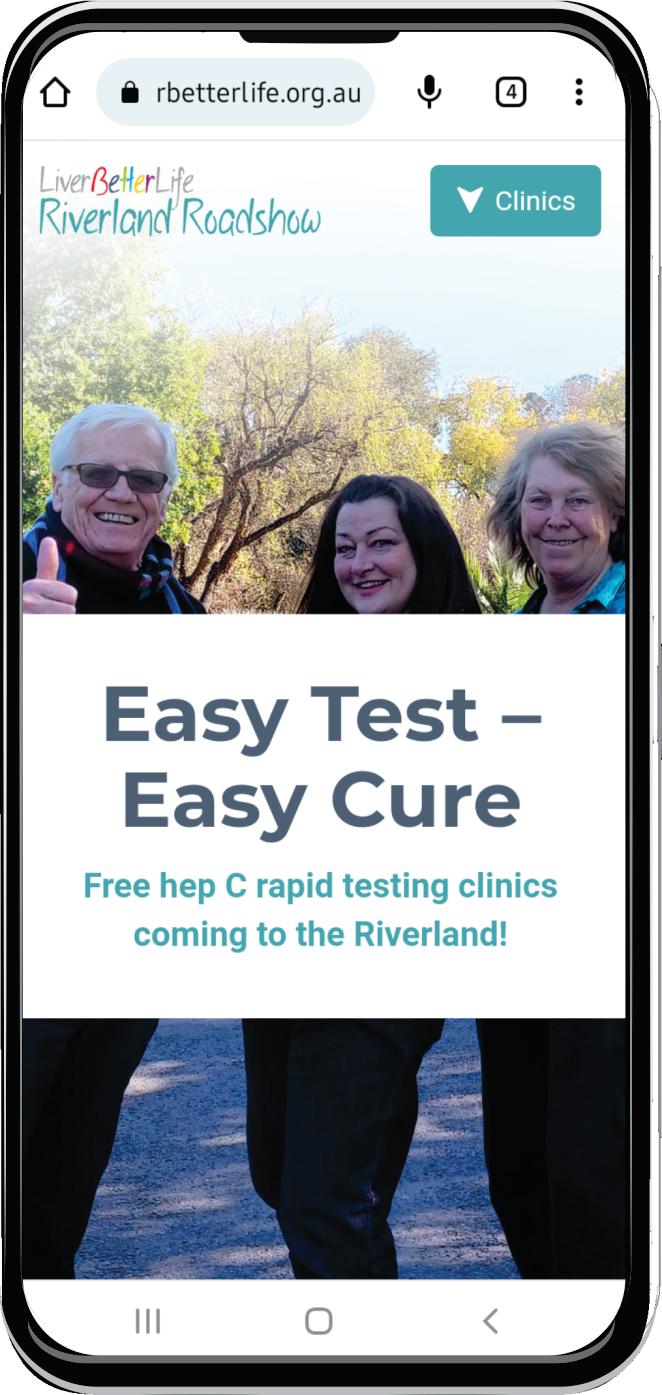
92% of participants said they learnt a lot about hepatitis B. and hepatitis C. All participants said the session improved their understanding of hepatitis C Point of Care Testing (PoCT), and that signi�cantly increased their likelihood of referring patients to the free hepatitis C testing clinics in the Riverland.
In total, 88 residents were screened. We were very pleased with the outcome of the campaign and would like to thank Riverland residents, businesses, ABC Riverland, Radio 5R M and the Murray Pioneer for their support and participation in the campaign. During the campaign, all Riverland residents were encouraged to take part in a free ra�e for a $500 Pike River Luxury Villa Voucher. Congrats to the lucky winner, Riverland resident, Angel H!
In total, 88 residents were screened. We were very pleased with the outcome of the campaign and would like to thank Riverland residents, businesses, ABC Riverland, Radio 5RM and the Murray Pioneer for their support and participation in the campaign.
During the campaign, all Riverland residents were encouraged to take part in a free ra�e for a $500 Pike River Luxury Villa Voucher. Congrats to the lucky winner, Riverland resident, Angel H!
Prison
Prison Quizzes
Hepatitis in Adelaide Mobilong Training displayed, call Hepatitis nursing question: hepatitis workers the opportunity C with them were entered winners
Hepatitis SA r in Adelaide W Mobilong Prison Training Cen displayed, pr call Hepatitis nursing sta� question: “Is hepatitis C?” workers and the opportunit hepatitis C them were entered winners from
World Hepatitis in
World Hepatitis in S
Cirrhosis Focus
Cirrhosis Focus
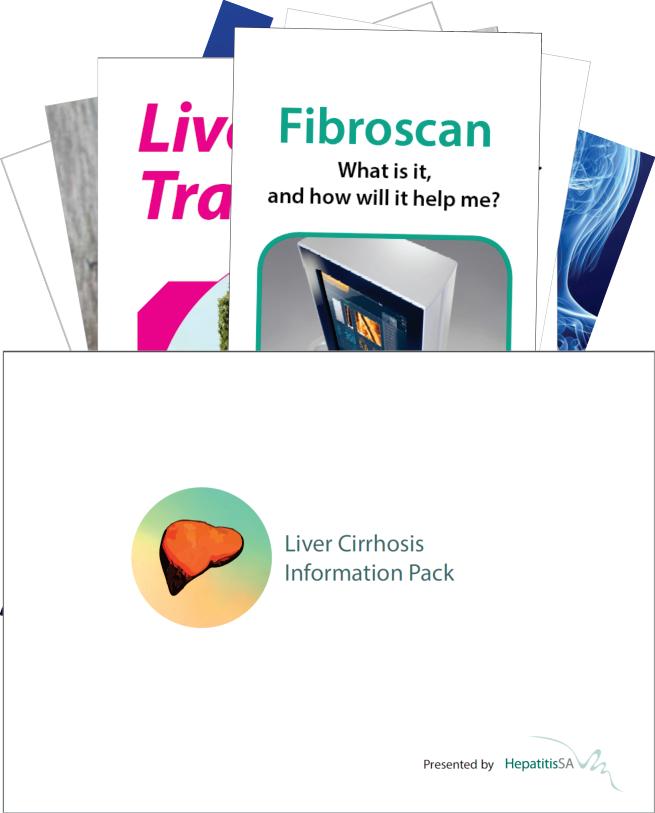

Some people continue to grapple with leftover liver disease even after being cured of hepatitis C. As part of their WHD activities, Haemophilia Foundation Australia, with support from Hepatitis SA, organised a focus group to discuss the information needs of people living with liver cirrhosis. Results from the focus group will be incorporated into an information pack being put together by Hepatitis SA.
Some people continue to grapple with leftover liver disease even after being cured of hepatitis C. As part of their WHD activities, Haemophilia Foundation Australia, with support from Hepatitis SA, organised a focus group to discuss the information needs of people living with liver cirrhosis. Results from the focus group will be incorporated into an information pack being put together by Hepatitis SA.
It ’s Your Right
It’s Your Right
CNP Program Coordinator, Carol Holly, spoke at the Burnet Institute/EC Australia webinar Hep Free by 2030 - Eliminating Hepatitis C is a Human Right. She spoke about Hepatitis SA's involvement in the campaign which highlights the need for a human rights approach to viral hepatitis elimination.
CNP Program Coordinator, Carol Holly, spoke at the Burnet Institute/EC Australia webinar Hep Free by 2030 - Eliminating Hepatitis C is a Human Right. She spoke about Hepatitis SA's involvement in the campaign which highlights the need for a human rights approach to viral hepatitis elimination.
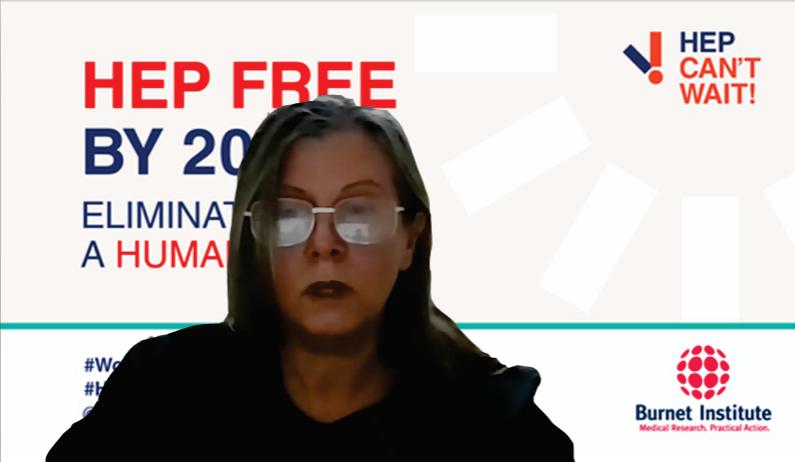
SAMESH
Hepatitis SA educator Gary did an interview for SAMESH discussing the impact of v hepatitis on liver health and wellbeing, symptoms, and work Hepatitis SA does to the community. A short v the interview was shared Facebook and Instagram. The complete interview can be a 27 minute podcast on the wellwellwell channel.

Hepatitis SA educator did an interview for discussing the impact hepatitis on liver health wellbeing, symptoms, work Hepatitis SA does the community. A short the interview was shared Facebook and Instagram. complete interview can a 27 minute podcast wellwellwell channel.

8 HEPATITIS SA COMMUNITY NEWS 95 • September 2022
SA MESH
Lots More Quizzes...

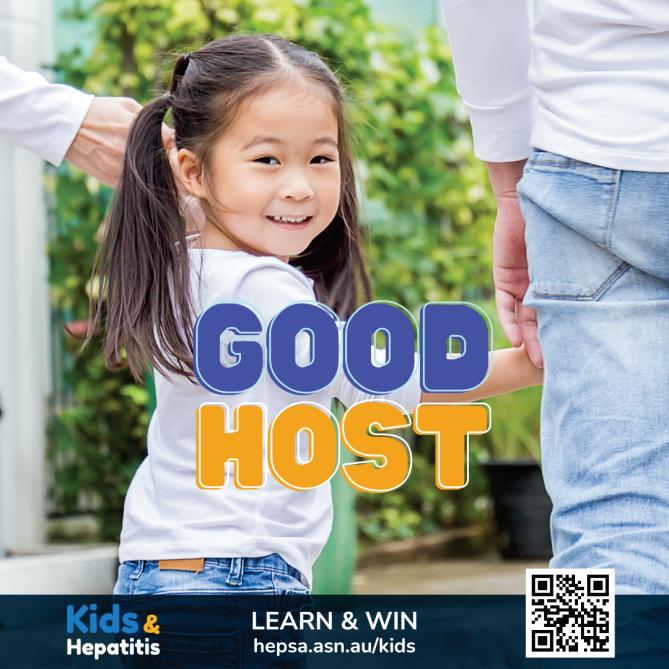
Prison Quizzes
Hepatitis SA ran competitions Adelaide Women's Prison, Mobilong Prison and Cadell Training Centre. Posters were displayed, prompting people to Hepatitis SA, or talk to sta�, to answer the question: “Is there a cure for hepatitis C?” This gave Helpline and prison health sta� opportunity to discuss hep them. Participants entered into a draw with winners from each site.

Hepatitis Day
SA
SAMESH
educator Gary Spence, SAMESH impact of viral health and symptoms, and the does to support short video of shared on Instagram. The can be heard as on the channel.

CNP Quizzes
The CNP Peer Projects ran a competition for CNP clients at DASSA Northern, Streetlink, Noarlunga and Wonggagga Turtpandi CNPs. To enter, CNP clients had to correctly answer a question about hepatitis C treatment and a question on hepatitis B vaccination.
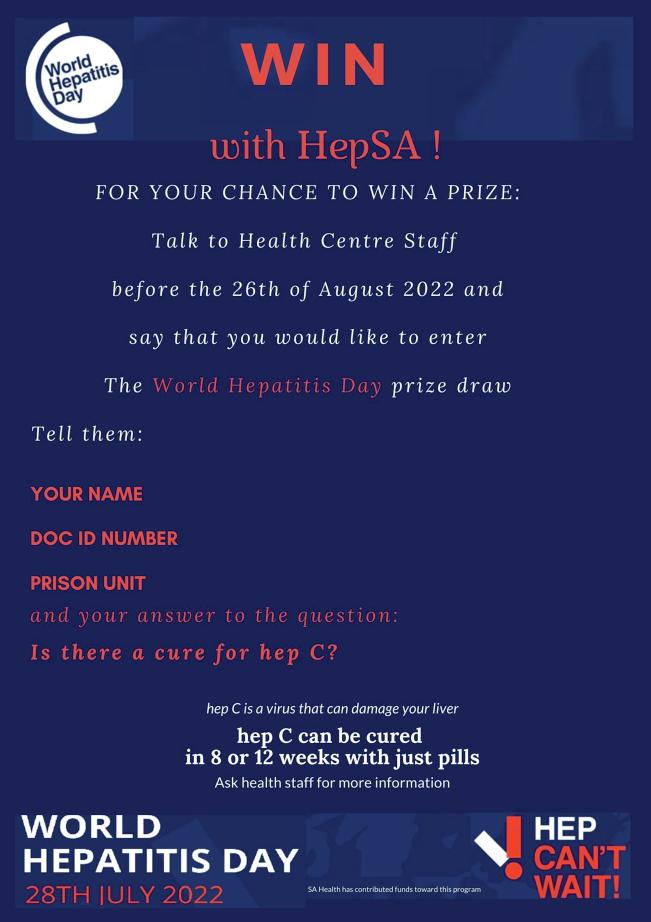
The WHD Quiz-Draw this year focused on how hepatitis a�ects children and the best ways to protect them against infection. This SA-only quiz received entries from 306 people, 260 of whom also answered the bonus question. The winner of the draw received a $500 voucher for the Oval Hotel in Adelaide.
Hepatitis SA also produced a little video as part of the WHD Global relay.
Hepatitis C Rapid Test Video

On World Hepatitis Day, Hepatitis SA launched a demonstration video illustrating the hepatitis C rapid testing process including pre-test counselling. The video can be used as a training tool or as an information resource for people considering testing. It can be accessed on the Hepatitis SA YouTube channel or via the Hepatitis SA Library.

September 2022 • HEPATITIS SA COMMUNITY NEWS 95 9
in
John’s Story
Haemophilia & childhood hep C
For most people who live with haemophilia and were exposed to hepatitis C through their treatment products, before proper testing was introduced, the diagnosis experience was more than 30 years ago. If they were diagnosed as a child, it might have been their parents who received the test results and they might not have been certain whether they still had hepatitis C until they were older.
John (name changed for privacy reasons) had hepatitis C as a child and cleared the virus naturally. He talked about his experience.
Being diagnosed
“It was in the early 1980s and not much was known about hep C at the time. I was a kid, around 9 or 10 years old, when I started passing dark brown urine, like tea. My parents thought that wasn’t right and sent me off to hospital. They ran tests and diagnosed that I had what was called non-A non-B hepatitis.
“I lost heaps of weight during that time and was very jaundiced and yellow. I can’t remember how long I was crook for, but I was
in hospital for two or three weeks. After that I had to get back up to strength and put weight back on and try to get back to normal.”
Although John and his parents didn’t speak much about it over the years, he found out later that his time in hospital was traumatic for all of them.
“I recall it being a bit like COVID times. I was in isolation in my own room and wasn’t really allowed visitors. My room had a glass window and my parents could only wave to me or speak to me from the outside of the window. The nurses and doctors were masked up as well.
“It was very daunting and scary as a kid. I was so young and didn’t know if I was going to survive the whole ordeal. And I still have mixed emotions when I think about how I obtained the virus through my blood products. You take a certain treatment for an illness that you think is going to save your life, and then you end up with another life-threatening virus or condition because of it. But I am probably one of the lucky ones. Other people got HIV. I cleared hep C naturally and I didn’t get HIV as well.”
Many years later, when John was celebrating a personal milestone, his normally stoic father was overwhelmed by the contrast between the happy occasion and the memory of John’s hepatitis C scare. His father broke down. “He said he wasn’t sure I was going to survive,” said John.
Clearing the virus
Although John isn’t sure when he cleared the virus, he has had several occasions where his HCV RNA tests have confirmed that he no longer has the virus in his bloodstream.
“I had to obtain a few doctor’s reports for one reason or another, and they specified that I was diagnosed with hep C in my childhood but had cleared the virus spontaneously and this was verified in blood tests.”
One of the tests for hepatitis C came during preparation for in-vitro fertilisation, when John and his wife were undertaking pre-genetic diagnosis for haemophilia before becoming pregnant. John explained that the IVF doctors identified that he had been exposed to hepatitis C, but could also see that he had cleared the virus.
10 HEPATITIS SA COMMUNITY NEWS 95 • September 2022
Stigma
Stigma relating to hepatitis C remains an issue for many affected people with bleeding disorders. For John, there is often no good reason to tell other people that he had hep C as a child.
“I cleared it naturally. It’s a thing in the past and doesn’t affect my day-to-day life any more.”
However, he is conscious that he has told very few people in his life—only very close family and family friends— because of the stigma. This was influenced greatly by his experiences as a child.
“I was in primary school when it all came out in the news that haemophiliacs had been infected with HIV or hep C through blood products. Obviously, my classmates knew I had haemophilia, and there was the stigma of them thinking do I have HIV or hep C? I didn’t disclose having hep C at the time to my classmates. It was a bit daunting, and I was worried whether I would be treated as an outcast, and by their parents as well. So that wasn’t a very pleasant time.

“I kept it to myself. My parents probably told a few close friends but that was it. It was
never spoken about outside that circle. And I thought their friends were a bit standoffish towards me after that. The stigma is a big thing, even in this day and age.”
Liver health checks
Keeping on top of his liver health is something that
John takes seriously. There are several factors that contribute to liver health, not just the effects or aftereffects of hepatitis C: for example, being overweight or drinking a lot of alcohol, or living with certain other health conditions. And even those who have cleared hep C will need ongoing liver health monitoring if they have already developed more severe liver scarring like cirrhosis.
John encouraged others to have any tests that are recommended for them individually, and to have hep C treatment if they haven’t already.
“Liaise with your treating doctor and see if you need more tests, because there are treatments now that can cure hep C in a short time if you still have the virus. Treatment has definitely come a long way from the early days!
“Keep an eye on your liver. Even though you might have been exposed to hep C 30 or 40 years ago, and you might have cleared the virus, it can still have some ramifications later in life. So it’s good to keep an eye on your liver and get any tests that you need, just to make sure there are no long-term consequences.” v
This story was first published on the Haemophilia Foundation Australia website ( haemophilia.org.au ) in July 2022, and is reprinted with permission.
September 2022 • HEPATITIS SA COMMUNITY NEWS 95 11 Image derived from illustration by Starline [freepik.com]
Overdose Awareness Day
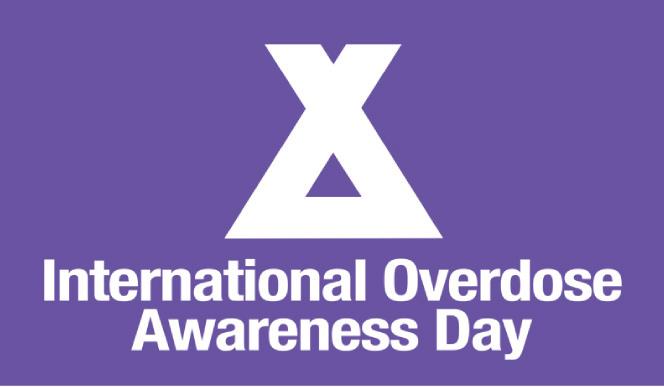
Hepatitis SA attended Aboriginal Community Connect for their Overdose Awareness Day fair. CNP Peer Projects Officer Margie Randle was asked to speak as a person with lived experience of overdose, a great opportunity for her to tell some of her story.

I am a drug user who has had my fair share of witnessing and experiencing drug overdoses. The first time it really hit me that I was really playing a life and death game was 25 years ago, when my boyfriend overdosed. I rang the ambulance, they came. I was relieved everything would be fine.
No. The paramedics walked around my flat, grabbed a beer out of the fridge and started abusing me. They didn’t care if my friend lived or died, he was just a junkie. I was wasting their time when they could be helping someone who deserved it.
Eventually they gave my friend Naloxone. Once, then another ampoule, then another one. On the fourth ampoule they said, “This is it—if he doesn’t come around it’s too bad.”
That’s when it hit me. He could really die. No messing about here. My mind went straight to having to ring his parents. What was I going to say? I’d have to organise a funeral. What if the police wanted to charge me? So many things going around in my
head as I stood there looking at my grey dying friend on the ground. But then he took a breath! The ambos packed up their stuff, mumbling and grumbling about us. The last thing they said to us was, “Don’t bother calling us again. We aren’t coming.”
If I’d had Naloxone in the house that day I wouldn’t have had to leave him, barely breathing, to run up to the phone box. I could have given him Naloxone. I would have had those four ampoules in the house. I wouldn’t have had to give mouth-to-mouth for what seemed like an eternity waiting for the ambulance. I wouldn’t have been abused and treated so badly.
I saw that paramedic again not long after. He was on 60 Minutes, speaking about helping his community, being the good guy. And this is just one story. I have many more. We now have access to Naloxone. It reverses the effects of opioids. It’s used in cases of overdose to bring
a person back. It is available from chemists, free. You don’t need a script.
A lot of chemists either don’t know about the program, or will try to take your name and details, which you don’t have to give them. They may not have it in stock. This happens a lot, but it should only take a couple of days for them to get it in. If they insist on taking your name or saying it’s not free or you need a script, tell them to ring DASSA.
Remember, the Naloxone program is not just for illegal opioid users. This is for people who are on opioids for pain medication. Your Uncle Jeffrey that has cancer and is in a lot of pain? This is for him. Your mum, who has had surgery and is in a lot of pain? Her too. Think about those people. Finally, you can’t administer Naloxone to yourself! If you are taking opioids and have Naloxone, you need to tell people where it is. Nobody can help you if they don’t know where it is! v
12 HEPATITIS SA COMMUNITY NEWS 95 • September 2022
Call Us!
Give Hep C the Finger!
Adelaide Remand Centre
Hep C fingerprick testing is available to remandees every Tuesday from November onwards.
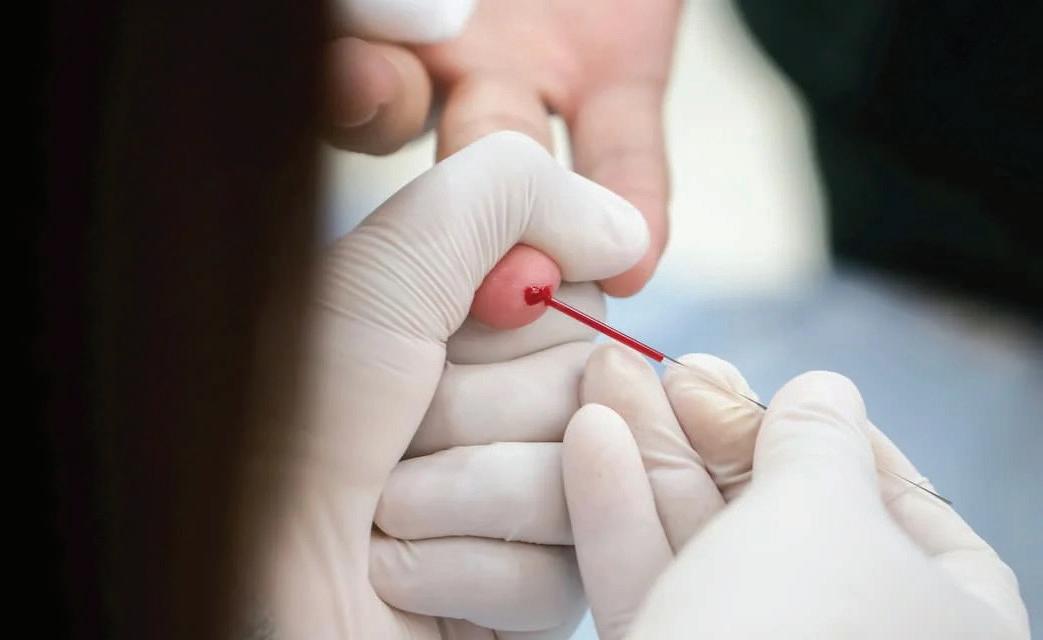
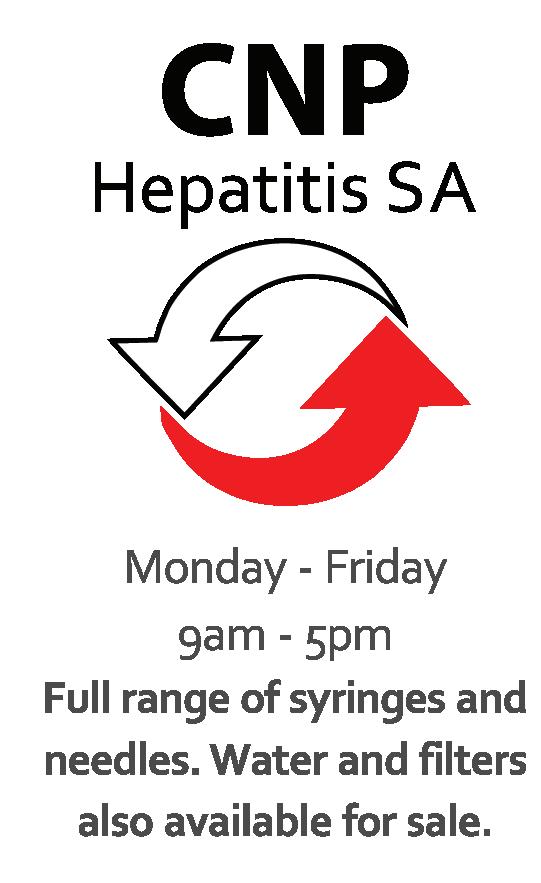
222
Don’t like Talking? No Problem.
Results provided on same day as test.
ALL ser ices & reso rces FREE
For more information, select number 8 from the ‘Common Access List’ for a free call from any prison phone, or ask for Lisa at HepSA on 8362 8443.

A Note to Our CNP Clients
We are approaching the COVID-19 pandemic with an abundance of caution in line with the recommendations of health experts.
We ask that you arrange for someone else to collect your equipment, if you have
• any flu-like symptoms such as fever and cough, or
• recently returned from travel overseas.
When collecting equipment, we ask that you cooperate with ‘social distancing’ recommendations:
• We will place equipment on a table for you to pick up: this will maintain social distancing
• We will fill out the data sheet
• We recommend that you collect a month’s supply of equipment (in case of any upcoming closures or supply delays)
• If you can ring ahead, please do so in case any further changes have taken place.
These measures are for YOUR safety as well as ours. Please respect the CNP workers so we can keep this service going!
September 2022 • HEPATITIS SA COMMUNITY NEWS 95 13
Free, confidential information and support on viral hepatitis: 1800 437
Visit hepsa.asn.au - no need to log in, lots of info & pdates Follo the HepSAY blog - hepsa.asn.a /blog Order print resources - hepsa.asn.a /orders/ Follo s on T i er @hep_sa or Facebook @Hepa sSA
and relevant infection control are the frontline for preventing the spread of communicable diseases— and clear guidance can minimise the stigma and discrimination arising from misinformation around this topic.
It’s worth noting that recent media articles have inaccurately implied that hepatitis can be transmitted via saliva: this has prompted Hepatitis Australia and the Australasian Society for HIV, Viral Hepatitis and Sexual Health Medicine (ASHM) to issue a statement to clarify this issue: see bit. ly/hepaust_ashm.
Below is a small selection of Australian guidelines and factsheets from reliable sources that are available free online. These, and more, are all listed in our online library catalogue.

Infection Control & Prevention
I NFECTION CONTROL gUIDELINES
CDNA National guidelines for healthcare workers on managing bloodborne viruses
Communicable Diseases Network Australia, Canberra, 2019. Guideline/factsheet collection.
Set of documents that outline best-practice infection control in Australian healthcare settings for healthcare workers living with, or at risk of exposure to, blood-borne viruses. bit.ly/CDNAguides
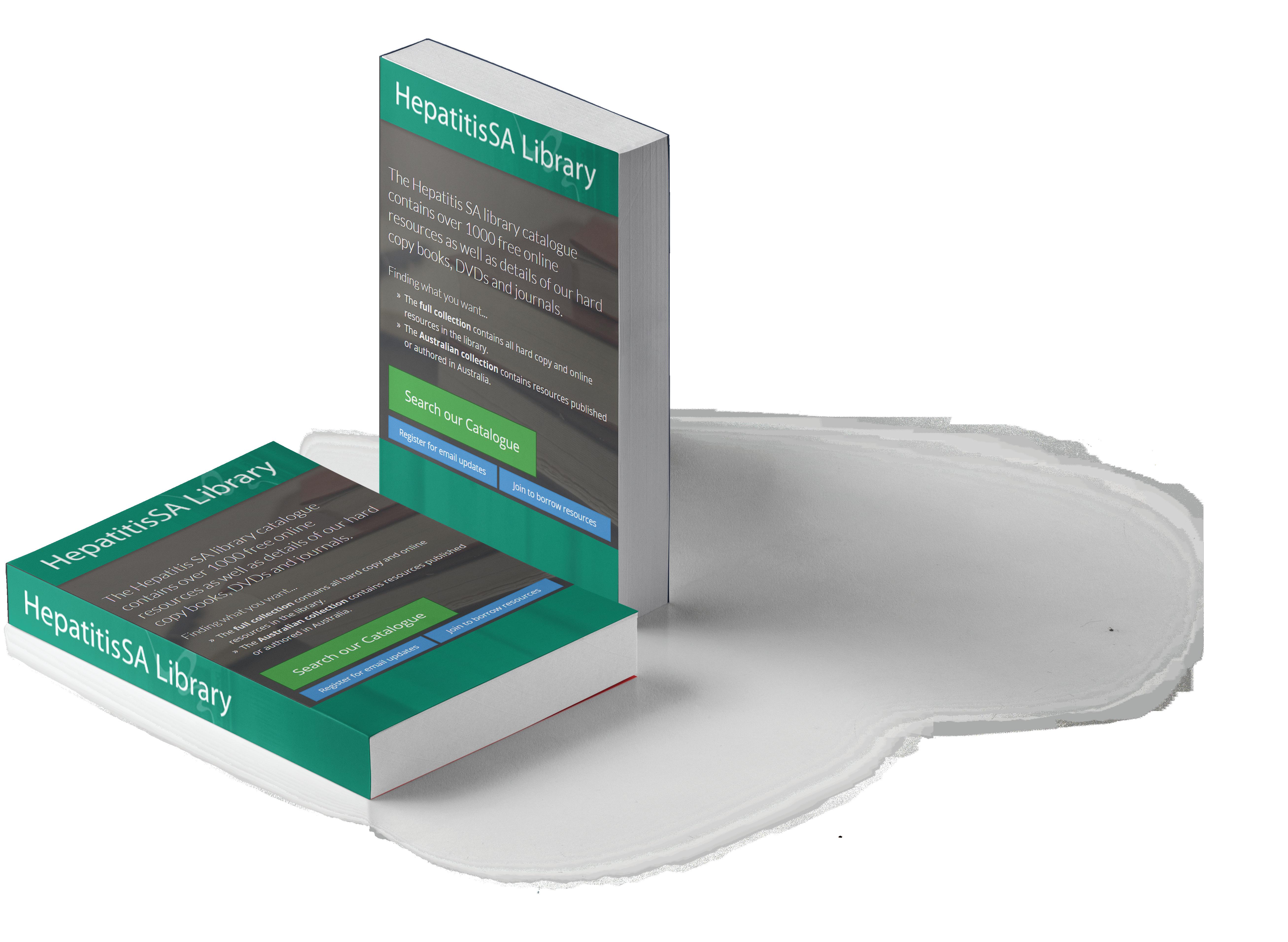
B vaccinated
Hepatitis Queensland, Brisbane, 2022. 1p. factsheet
Brief information about protecting ‘our mob’ from hepatitis B: vaccination regimes for adults and bubs. From the ‘B Stonger’ initiative for Aboriginal and Torres Strait Islander peoples. bit.ly/bstrongervax
P REVENTION
Cleaning up body fluid spills (blood, urine, saliva, faeces, etc)

Hepatitis SA, Adelaide 2021 (rev)
VACCINATION
Hepatitis B vaccination FAQ
Hepatitis SA, Adelaide, 2018. 2p. factsheet
Answers to frequently asked questions about hepatitis B vaccination (South Australia). Read online only – contact admin@hepsa.asn.au for hard copies
Chinese version: bit.ly/ hepbvax_chi
English version: bit.ly/ hepbvax_eng
A set of 3 posters on safe handling of blood spills and sharps, and where to get help in South Australia. bit.ly/spills1
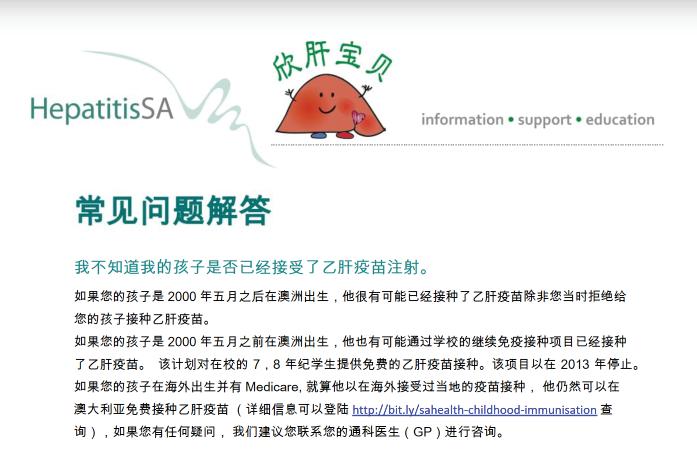
14 HEPATITIS SA COMMUNITY NEWS 95 • September 2022
Virus protection in your workplace
Hepatitis Queensland, Brisbane, 2020. Video 1:22 minutes
Brief animation that aims to help businesses protect their staff from several viruses that can be transmitted in the workplace. bit.ly/workplaceprotect
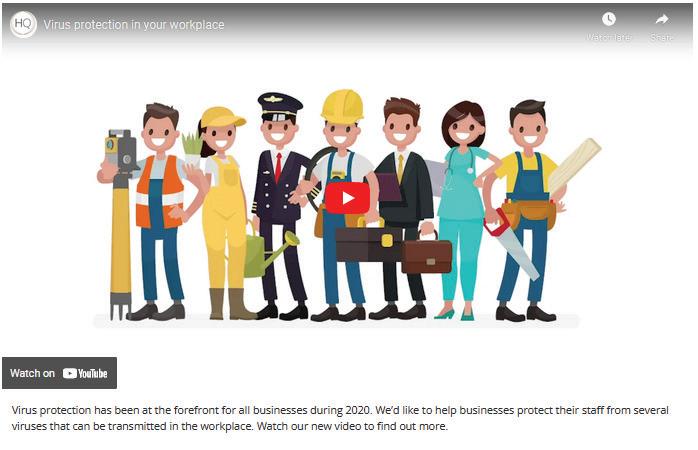
Protect yourself: be blood aware
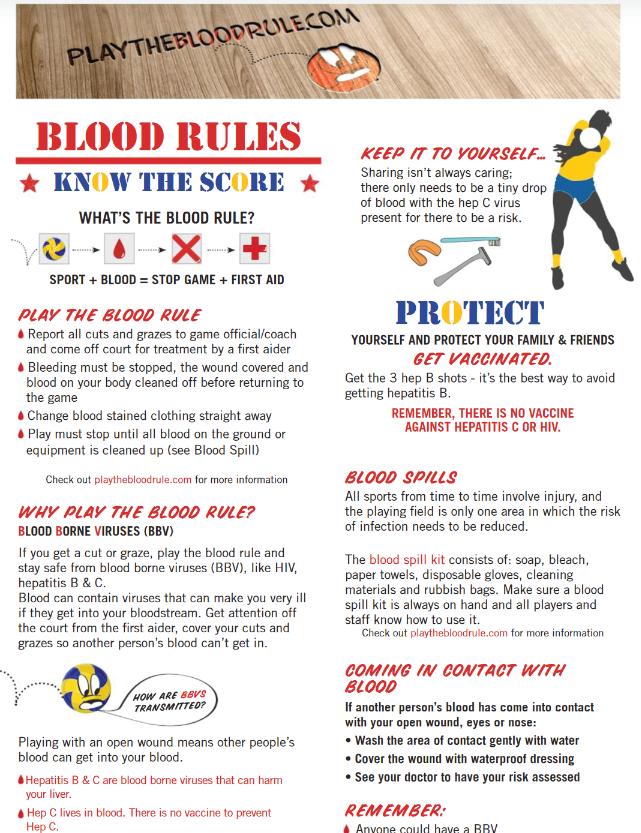
Nunkuwarrin Yunti, Adelaide, 2019. Poster Concise information in poster format encouraging people to contact their doctor for follow up in cases of blood exposure. bit.ly/bloodaware
What to do if you find a used needle
Hepatitis Queensland, Brisbane, 2019. 2p. factsheet. Outlines 4 steps in disposing of used syringes safely and what the risks are with needlestick injuries. bit.ly/usedsyringe

First aid and standard precautions
Hepatitis Queensland, Brisbane, 2019. 1p factsheet
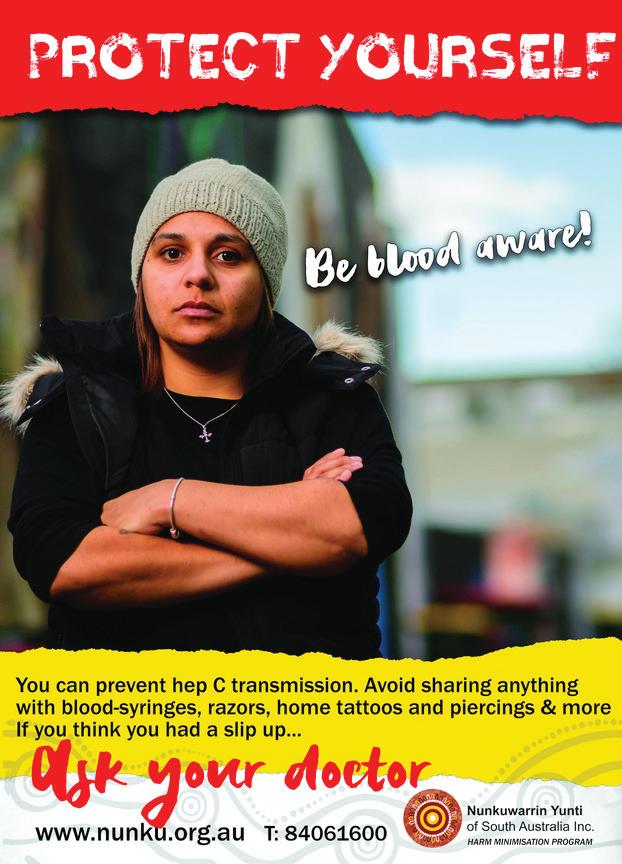
The basic precautions that should be followed in all cases where there is a risk of blood contact, with additional information where first aid needs to be administered. bit.ly/firstaid_qld
Health information for clients of hair, beauty, tattooing and skin penetration industries
Health Vic., Melbourne, 2019. 2p factsheets
These factsheets contain information about risk and safety factors and how to assess the most safe service provider. bit.ly/skinpenetration1 bit.ly/tattooingsafety

Needlestick injuries
LiverWELL (Hepatitis Victoria), Melbourne, 2018. 2p. factsheet
Explains the risks if incurring a needlestick injury, what to do in the immediate timeframe, what follow up is needed and how to avoid injury in the future. bit.ly/needlestick1
Blood rules - know the score
Hepatitis SA, Adelaide, 2015. 1p. factsheet
Explains the Blood Rule in sports, including basic information on blood borne virus transmissions. Read online only – contact admin@ hepsa.asn.au for hard copies. bit.ly/bloodrules_hepsa
To access a wider listing of available resources: go to the catalogue (bit. ly/hepsalibrary), scroll down to the ‘Australian community resources’ list, and click on ‘transmission’. The ‘prevention/infection control’ heading leads to a comprehensive list of publications that can be refined using the topic list on the left-hand side.
September 2022 • HEPATITIS SA COMMUNITY NEWS 95 15
to engage with people who inject drugs, especially more marginalised injectors, and to facilitate increased access to hep C testing and treatment for our clients. Having CNP peers working with and supporting hep C peers provided an opportunity to work more closely across programs within Hepatitis SA. The campaign was also an opportunity to recruit and train more peer workers, including 2 Aboriginal peers which has led to increased engagement with Aboriginal people who inject drugs.
Some notable ‘It’s Your Right’ Health Promotion Campaign Successes:
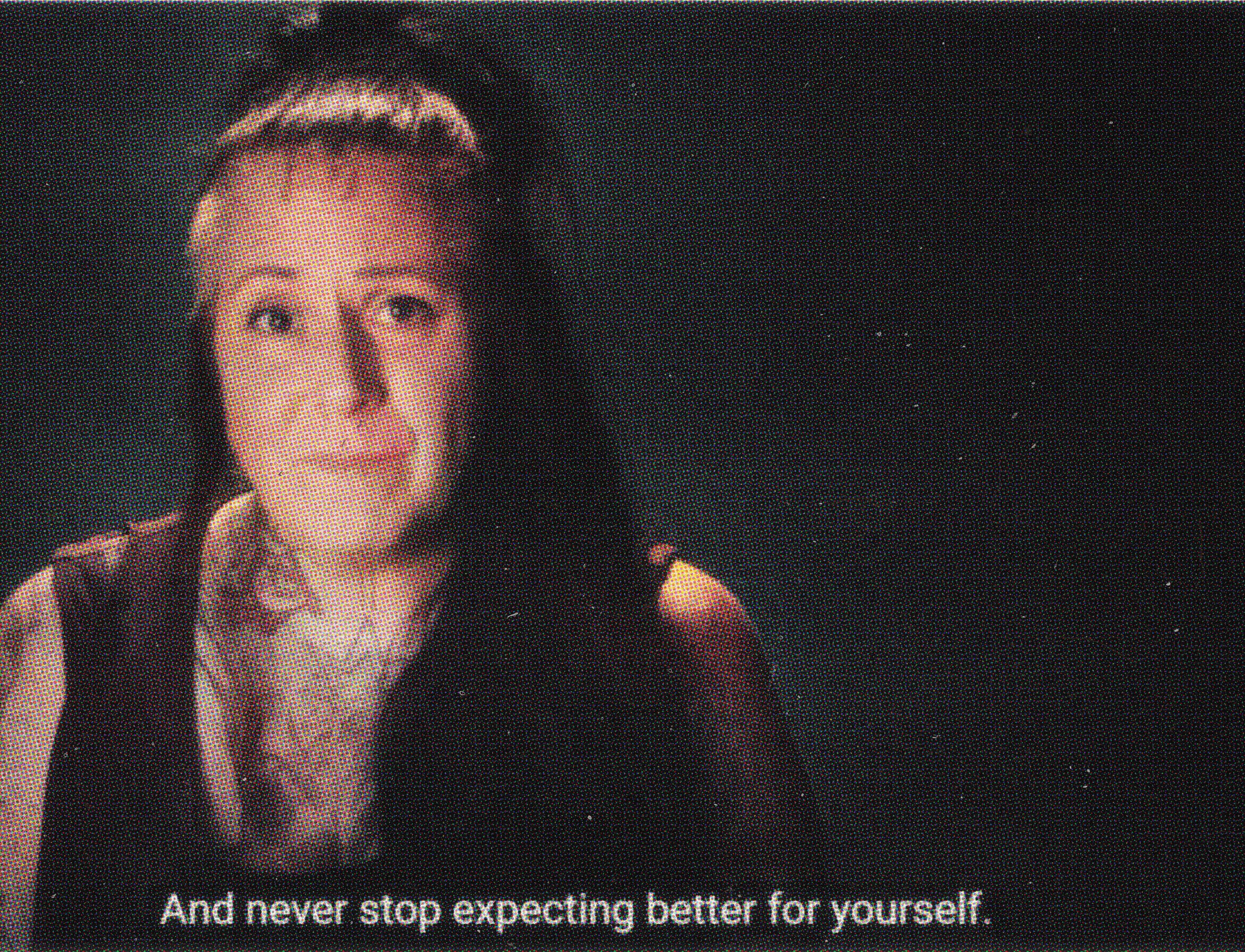
• 205 people who inject drugs were tested for hepatitis C; 44 (21%) were Aboriginal and/or Torres Strait Islander clients, who can face many barriers to testing.
• All 30 HCV RNApositive participants (15% of those tested) were referred to hep C treatment. Five of the HCV RNA-positive clients (17%) were Aboriginal and/or Torres Strait Islanders.
• Another 3 participants had been treated for hep C and had cleared the virus, but their test results showed that they had
been reinfected. These 3 people were referred to the viral hepatitis nurses to be retreated.
• The ‘bring a friend’ incentive has been very successful in attracting more clients for HCV point-of-care testing.
In addition to the peer engagement component of the campaign, there was a series of posters encouraging people who inject drugs to get tested for hep C. The posters were placed in laneways, public areas, shopping centres and even on metro buses. There was good feedback about the posters, with people commenting on the bright colours as a welcome change from some of the usual hepatitis C health promotion resources. Most of the feedback related to the “Get Clear on Gear” poster which received positive feedback from everyone who commented on it.
For more information on hepatitis C testing and treatment, or to view video testimonials from people who have cleared hepatitis C through treatment, go to itsyourright.com.au v
www.itsyourright.com.au
16 HEPATITIS SA COMMUNITY NEWS 95 • September 2022
» (continued from p1)
Useful Services & Contacts
Hepatitis SA
Free education sessions, printed information, telephone information and support, referrals, clean needle program and library.
(08) 8362 8443 admin@hepatitissa.asn.au www.hepsa.asn.au
Hepatitis SA Helpline
1800 437 222 (cost of a local call)
Adelaide Dental Hospital
A specially funded clinic provides priority dental care for people with hepatitis C with a Health Care Card. Call Hepatitis SA on 1800 437 222 for a referral.
beyondblue
Mental health information line
1300 224 636 www.beyondblue.org.au
Clean Needle Programs in SA
For locations visit the Hepatitis SA Hackney office or call the Alcohol and Drug Information Service. 1300 131 340
Community Access & Services SA
Alcohol and drug education; clean needle program for the Vietnamese and other communities.
(08) 8447 8821
headspace
Mental health issues are common. Find information, support and help at your local headspace centre 1800 650 890 www.headspace.org.au
Hutt St Centre
Showers, laundry facilities, visiting health professionals, recreation ac tivities, education and training, le gal aid and assistance services pro vided to the homeless.
258 Hutt St, Adelaide SA 5000
(08) 8418 2500
Lifeline
National, 24-hour telephone counselling service.
13 11 14 (cost of a local call) www.lifeline.org.au
Mental Health Crisis Service
24 hour information and crisis line available to all rural, remote and metropolitan callers.
13 14 65
MOSAIC Counselling Service
For anyone whose life is affected by hepatitis and/or HIV.
(08) 8223 4566
Nunkuwarrin Yunti
An Aboriginal-controlled, citybased health service, which also runs a clean needle program.
(08) 8406 1600
Viral Hepatitis Community Nurses
PEACE Multicultural Services
HIV and hepatitis education and support for people from nonEnglish speaking backgrounds.
(08) 8245 8100
Sex Industry Network
Promotes the health, rights and wellbeing of sex workers.
(08) 8351 7626
SAMESH
South Australia Mobilisation + Empowerment for Sexual Health www.samesh.org.au
Youth Health Service
Free, confidential health service for youth aged 12 to 25.
Youth Helpline: 1300 13 17 19
Parent Helpline: 1300 364 100
Viral Hepatitis Nurses work with patients in the community, general practice or hospital setting. They are located in the Adelaide metro area but support can also be arranged for people in country areas. They can be contacted directly by patients or their GPs:
CENTRAL: QUEEN ELIZABETH HOSPITAL
Jeff: 0423 782 415
Debbie: 0401 717 953
NORTH
Bin: 0401 717 971
SOUTH
Rosalie: 0466 777 876
Lucy: 0466 777 873
OFFICE: (08) 8204 6324
Specialist Treatment Clinics
Subsidised treatment for hepatitis B and C are provided by specialists at the major hospitals. You will need a referral from your GP. However, you can call the hospitals and speak to the nurses to get information about treatment and what you need for your referral.
• Flinders Medical Centre Gastroenterology & Hepatology Unit: call 8204 6324
• Queen Elizabeth Hospital: call 8222 6000 and ask to speak a viral hepatitis nurse
• Royal Adelaide Hospital Viral Hepatitis Unit: call Anton on 0401 125 361
• Lyell McEwin Hospital: call Bin on 0401 717 971


Free hepatitis A, B and C information, confidential and non-judgemental support, referrals and printed resources. We can help. Talk to us. Call or web chat 9am–5pm, Mon–Fri 1800 437 222 hepsa.asn.au Information Support




















































































































































